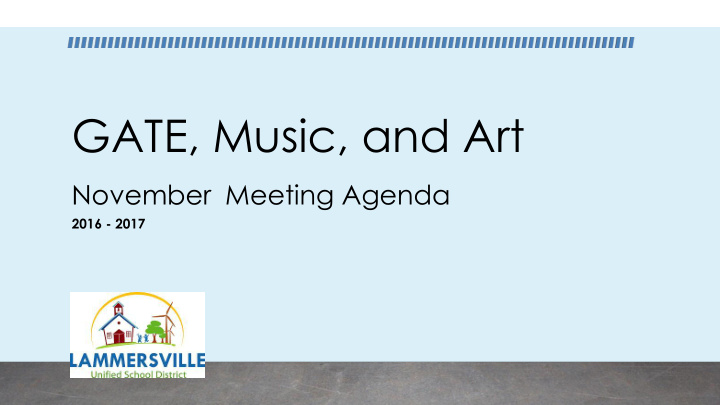



GATE, Music, and Art November Meeting Agenda 2016 - 2017
Agenda: November 29, 2016 • Welcome and Introductions • GATE testing update • Exploring a GATE program offering
GATE Testing update • 3 rounds of NNAT2 testing • 41 students tested • 20/41 at 90 th percentile or higher on NNAT2 • 11/41 at the 98 th percentile or higher on the NNAT2 • Multiple measures being collected now • Parent Referral form • Teacher profile • Work samples • Test data (MAP, CAASPP, CELDT) • Report cards
Next steps • Review all data to determine cut points for GATE qualification • Notify teachers and parents of determination results • Teachers deliver enrichment curriculum in class • Develop GATE supplemental program
The State of GATE http://www.blogtalkradio.com/edutalk/2015/12/ 11/the-state-of-the-nation-in-gifted-education
“The LCFF provides a unique opportunity for local educational agencies (LEAs) to expand upon or develop new education opportunities for high-ability students in California public Local Control elementary and secondary schools, particularly those who are traditionally Funding underrepresented in GATE programming. The LCFF requires stakeholder input during the development of Local Control Accountability Formula Plans (LCAP), further expanding the opportunity for educators, families, and other stakeholders to provide input as LEAs develop their annual budgets.”
Standards in GATE 1. Program Design: Districts provide a comprehensive continuum of services and program options responsive to the needs, interests, and abilities of gifted students and based on philosophical, theoretical, and empirical support. (EC 52205[d] and 52206[a])
Standards in GATE 2. Identification: The district’s identification procedures are equitable, comprehensive, and ongoing. They reflect the district’s definition of giftedness and its relationship to current state criteria. (EC 52202: Title 5 Regulations, Section 3822)
GATE in Lammersville Today We screened all 4th graders for scoring Advanced on MAP or CAASPP in any one or more areas. We offered to test all of those students at the parent’s discretion. Nearly all agreed to testing. Then we gave them the NNAT2. On the NNAT 2 June testing, 9 out of 15 of the students tested at the 99th percentile. In October testing we had 1 out of 16 test at the 99th and 1 out of 16 at the 97th percentiles. There was one more at the 95th percentile too. On the other round of testing we had 1 out of 10 at the 99th percentile and the next one was at the 93rd. We initially identified 28 students. We re-screened the 5th graders at the start of this year to catch any new students or additional students we should consider and got 17 more. This is equal to roughly 9% of our 5th grade population.
A Practical Method For Identifying Gifted and Talented Students From Renzulli Center for Creativity, Gifted Education, and Talent Development: http://gifted.uconn.edu/schoolwide-e nrichment-model/identifygt/
Standards in GATE 3. Curriculum and Instruction: Districts develop differentiated curriculum, instructional models and strategies that are aligned with and extend the state academic content standards and curriculum frameworks. The differentiated curriculum is related to theories, models, and practices from the recognized literature in the field. (EC 52206[a] and 52206[b]) Identify teachers for after school GATE offerings using teacher survey , as well as provide staff development for teachers with GATE-identified students in their classrooms.
Standards in GATE 4. Social and Emotional Development: Districts establish and implement plans to support the social and emotional development of gifted learners to increase responsibility, self-awareness, and other issues of affective development. (EC 52212[a][1]) Include Social and emotional supports as part of after school GATE ● enrichment offerings.
Standards in GATE 5. Professional Development: Districts provide professional development opportunities related to gifted education to administrators, teachers, and staff to support and improve educational opportunities for gifted students. (EC 52212[a][1]) *Identify Teachers for GATE training and education with survey.
Standards in GATE 6. Parent & Community Involvement: Districts provide procedures to ensure consistent participation of parents and community members in the planning and evaluation of programs for gifted students. (EC 52205[2][f]) Student Interest Survey Parent Survey to be sent mid-January
Recommend
More recommend